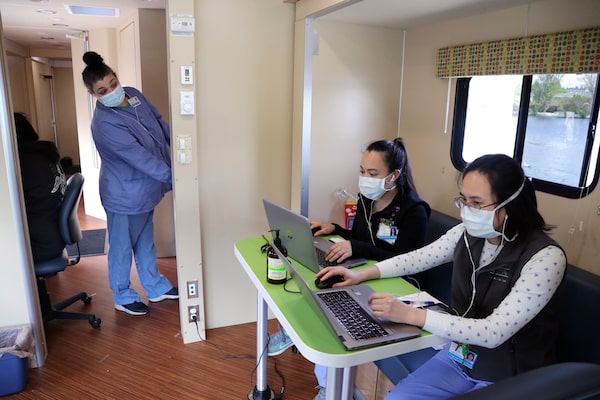
Workers prepare records by cell phone for patients driving up to a coronavirus testing site Wednesday, April 29, 2020, in Seattle.Elaine Thompson/The Associated Press
Epidemiological math has become our national obsession. An anxious country scans the curves of infection and death and measures their angles, looking for signs of progress.
And progress there has been. The economic toll has been enormous and too many lives have been lost, but the signs are there that the spread of infections has been substantially slowed, from coast to coast. It’s why Canada’s provinces are beginning to sketch out plans to gradually reopen parts of the economy.
The timing of each small step toward normalcy will depend on the degree to which the virus is checked. And keeping the virus in check is unlikely to be possible without an extensive program of testing.
Testing, testing, testing has been a mantra from the beginning. Until there is a vaccine, it will be a key tool.
Extreme physical distancing, and the attendant economic freeze-up, contained the first wave of the virus. Testing, and contact tracing everyone connected with those who test positive, offer the best hope for safely restarting much of the economy, while preventing a new wave of infections.
Unfortunately, testing capacity in Canada remains short of what is necessary.
Last week, Canada’s Chief Public Health Officer, Theresa Tam, cited an initial target for testing of 60,000 people each day. On Monday, Canada tested just 26,000.
And that was the highest figure to date, as Ontario has finally increased testing after badly lagging. There is still a long way to go, and Dr. Tam’s target may only do as a first step. Even higher levels of testing will likely be needed.
According to a recent report from researchers at Harvard University, the hard-hit United States will need at least five million tests a day by early June to set the country on a course for a safe reopening. By midsummer, the report called for 20 million daily tests “to fully re-mobilize the economy.” (The U.S. tested 220,000 a day in the past week.)
Five million daily tests in the U.S., when adjusted for Canada’s lower population, is equivalent to nearly 600,000 tests a day. That’s more than 20 times Canada’s current rate.
The numbers are high because they assume the need to test anyone with symptoms, and everyone in contact with them. At-risk groups, as in nursing homes, need regular testing. Health care workers and others in essential jobs need repeated testing. Anyone who is infected needs to be isolated. There also appears to be good reason to consider some random testing of asymptomatic people outside of at-risk sites.
The challenge with this virus is that evidence strongly suggests it is transmissible by people showing no symptoms.
In the Second World War, radar and sonar were two of the Allies’ most important weapons. They could spot an enemy hidden under the sea or lurking over the horizon. In today’s war, testing is our early-warning system. It reveals a virus that prefers to move by stealth.
When it comes to ramping up testing, the provinces have had varied results. Ontario was criticized, and with good reason, for backlogs and lack of testing in the pandemic’s early weeks. It once aimed to reach 19,000 tests a day by mid-April; it is now targeting 16,000 by early May. It needs to hit that number, and keep growing.
British Columbia tested most aggressively as the pandemic took hold in mid-March, and the curve of new infections flattened more quickly than in other big provinces. Relatively fewer people have died or been hospitalized, compared with Ontario and Quebec.
B.C.’s testing rate is now lower than elsewhere, though its low percentage of positive tests suggests no unseen outbreak. In recent days, B.C. tested an average of 2,000 people. The province’s current daily capacity of 7,000, however, would be close to meeting Dr. Tam’s initial testing target. On Monday, B.C. Provincial Health Officer Bonnie Henry said the province is now able to test anyone with symptoms, including mild symptoms similar to a common cold.
That should have been the minimum standard across Canada weeks ago.
The bottom line is that, on a national basis, the capacity to test, and to quickly trace the contacts of positive cases, is still not where it needs to be.
Physical distancing helped Canada avoid a worst-case scenario. Mass testing will help win the next phase of the battle: reopening the economy, and keeping it open.
As regular flu season winds down, Dr. Theresa Tam says that's opening lab capacity to do more testing for COVID-19. And she says the federal government is ready to link volunteer contact-tracers to provincial needs, to track down people who might have caught the illness from people who test positive for it.
The Canadian Press
Know what is happening in the halls of power with the day’s top political headlines and commentary as selected by Globe editors (subscribers only). Sign up today.